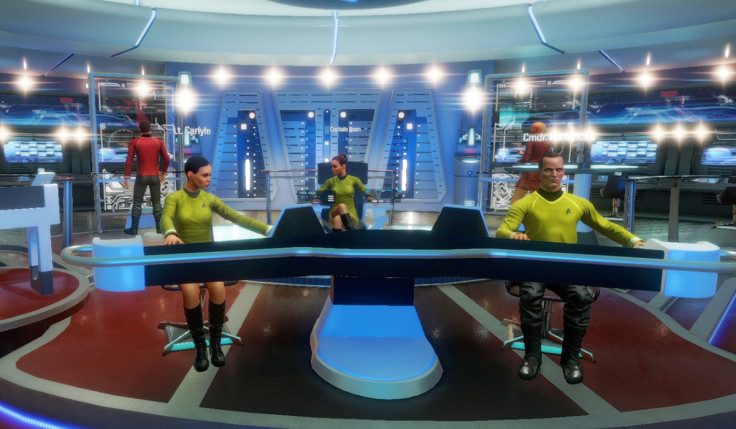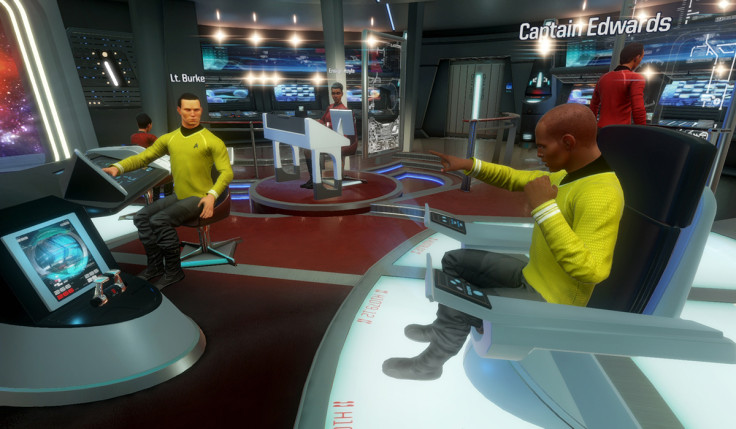Star Trek Bridge Crew could be the unlikeliest VR killer app
Red Storm Entertainment's simple space sim mines virtual reality for its fun potential.

"Punch it!"
If I hadn't struggled to find the warp thruster immediately after my captain barked this order, it would have been a much cooler moment. I found it, eventually, and engaged the warp drive, turning the stars outside into streaks of light as we burst forward, tearing through space toward our inaugural mission.
Ubisoft's Star Trek Bridge Crew casts four players in key roles aboard a Federation vessel. The captain is naturally in charge, with the remaining three in control of piloting, weapons systems and engineering.
We're aboard the USS Aegis, or rather the USS Not-The-Enterprise-But-Basically-The-Enterprise, on a mission not to explore strange new worlds, but to rescue stranded people from the wreckage of a ship that has strayed too close to a collapsing star.
As the pilot, I plotted our course, avoiding asteroids, making a heading and warping to the destination. From there I directed the enormous ship towards the people in need of assistance, before a Klingon warship arrived and opened fire. As I moved the ship closer to our quarry, my crewmate in charge of engineering warped survivors aboard as the other returned fire on the Klingons.
We rescued two sets of people and dispatched the Klingons bothering us, but several more ships appeared and were making short work of our shields.
Star Trek Bridge Crew sounds fun without the application of virtual reality, but it's VR that makes it all the better. Heading to PlayStation VR, Oculus Rift and HTC Vive later on 29 November – the game is one of the more fun VR experiences I've had since the technology re-emerged over the past few years.
It's also, by the sounds of it, one of the most complete games coming to any VR headset. A story-driven campaign consisting of missions like the one demoed to me at Gamescom 2016, will form the basis, but crucially there's another mode that'll create procedural missions – lending the game longevity.

Virtual reality often makes for secluded experiences. Users strap on a headset that shuts them off from the outside world, and they enter largely single player games and demos. It's something the virtual reality market needs to overcome to appeal to a mass audience, and it's where games like Star Trek Bridge Crew will garner mass appeal.
Before starting a mission, players choose their name, and gender if they wish, before a character is then generated that all other players are able to see. Looking around the bridge — inspired by the more recent Star Trek films — you see other characters' movements in real time.
This mostly involves people playing waving their arms around. Bridge Crew is played through an interface below the player that is interacted with using natural hand movements, but your hands aren't floating as in most VR games — they have arms attached to them, connected to a body you can look down and see.
It's a surreal experience, but engaging. One player looked down and voiced his dismay at wearing a red shirt, another struck the 'thinking man' pose as we plotted our next move.
In action, Bridge Crew is a game about team work reminiscent of mobile game Spaceteam, but a lot less chaotic. Players communicate to devise plans and alert the team to threats. Everyone has their role, and the captain needs to maintain some kind of order.
As our mission came to an end and we were required to make a quick getaway, the systems had fallen into place. I positioned us, the warp cores were charged and I was ready to jump. "Punch it!" This time, it was right out of the movies.
For all the latest video game news follow us on Twitter @IBTGamesUK
© Copyright IBTimes 2025. All rights reserved.





















